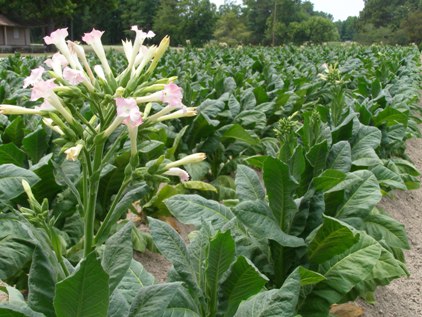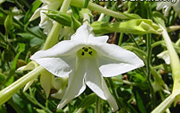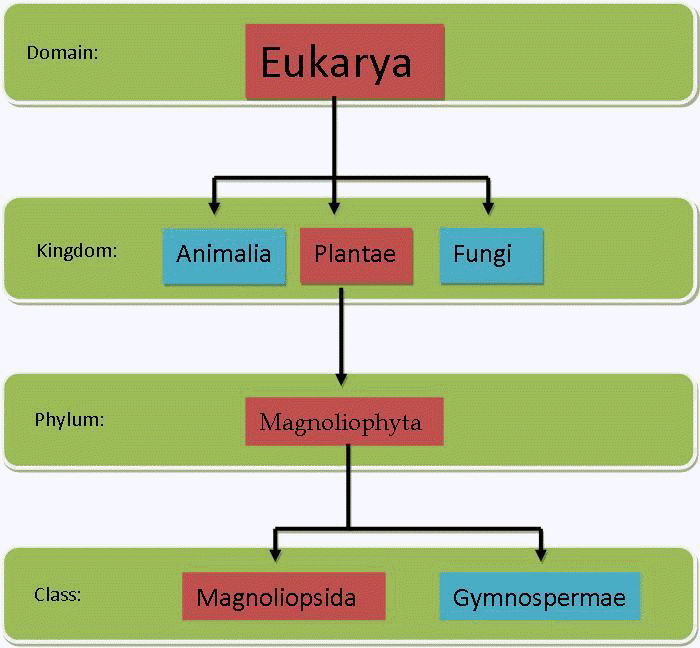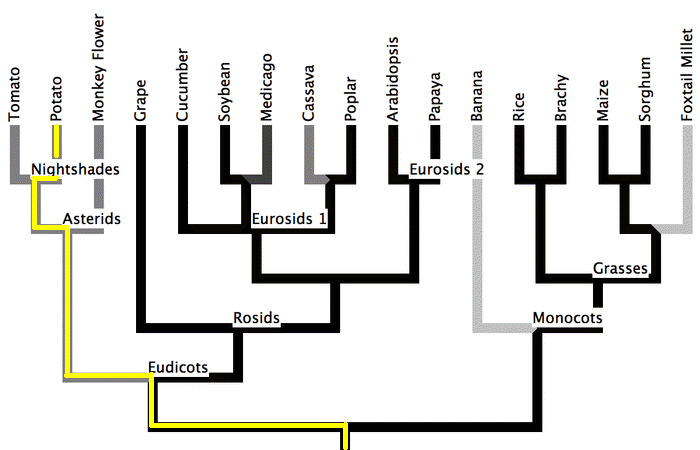
Classification
The origin of the word "Nicotiana", or nicotine, came from a French ambassador to Portugal called Jean Nicot de Villemain. In 1560 she became familiar with the plant and offered the seeds as a gift to Catherine de’ Medici. The plant soon called “herbe de l’ambassadeur” was cultivated in Paris and under her name Carl Linnaeus introduced the plant to botany. The specific epithet "tabacum" simply is translated to tobacco in English.
Classification information
Domain: Eukarya
Kingdom: Plantae
Phylum: Magnoliophyta
Class: Magnoliopsida
Order: Solanales
Family: Solanaceae
Genus: Nicotiana
Species: Nicotiana tabacum
Domain: Eukarya
Tobacco is part of the domain Eukarya. The word eukarya can be broken down into "eu" meaning true, and "karya" meaning nucleus. Tobacco belongs to this domain because it is composed of eukaryotic cells, which contain a true nucleus and many membrane bound organelles.
Kingdom: Plantae
Tobacco is part of the kingdom Plantae because it is a green plant that harvests most of its energy from sunlight via photosynthesis.
 Phylum: Magnoliophyta
Phylum: Magnoliophyta
Tobacco is part of the phylum Magnoliophyta which is a group that contains all of the seed bearing vascular plants or otherwise known as angiosperms.
Class: Magnoliopsida
Tobacco is part of the class Magnoliopsida because the plant contains seeds within closed capillary structures called ovaries resulting in flowers. The dicotyledonous plants are also grouped within this class and they all have primary and secondary vascular tissue to allow for secondary growth in the plant.
Order: Solanales
Tobacco is part of the order Solanales because of its toxic nicotine content. Plants in the order Solanales possess branched hairs, often spines, and commonly have alkaloids, like poison ivy, associated with them, which makes them poisonous.
Family: Solanaceae
Tobacco is part of the family Solanaceae because they are dicotyledonous plants that are in the “nightshade family”, with coffee, the potato, but interestingly enough not the sweet potato. These plants have been highly cultivated over the years for consumer use among people. Most of the plants in this family are herbaceous with terminal clusters of regular flowers usually borne in a cyme with estipulate leaves. There are usually five sepals, petals, and anthers in this family of plants.
 Genus: Nicotiana
Genus: Nicotiana
Tobacco is part of the Genus Nicotiana because it is a group of herbs and shrubs in the “nightshade” family and are cultivated and grown to produce tobacco.
Phylogenetic trees:
 This phylogenetic tree reflects the taxonomic information
above and shows the broad domain, kingdom,
phylum, and class that tobacco fits under.
This phylogenetic tree reflects the taxonomic information
above and shows the broad domain, kingdom,
phylum, and class that tobacco fits under.
Tobacco's journey first starts out in the Domain: Eukarya because
it is composed of cells called eukaryotes that have a true nucleus
accompanied by membrane-bound organelles.
Tobacco is then classified under the Kingdom: Plantae because it is
a green plant that harvests most of its energy via photosynthesis
and acts as a primary producer in its environment.
This phylogenetic tree depicts all of the angiosperms and their lineages.
Tobacco's first divergence is to the eudicots which is
morphological. Tobacco is considered to be in the eudicots
because it contains flower parts in multiples of 4 or 5, possesses
two cotyledons, has web-like veins in its leaves, has a main tap
root, and the vascular tissues are arranged in a ring allowing for
secondary growth. Monocots have flower parts in multiples of
3, possess only one cotyledon, has parallel veins in its leaves,
does not possess a main tap root, and the vascular tissue is
scattered throughout the stem allowing for only primary growth in
the plant.
Tobacco's second divergence is located at the asterids. Tobacco is
considered to be a part of asterids I while the "Monkey Flower" is
part of the asterids II. These two classes can be
distinguished apart from each other morphologically by the fact that
the asterids I appear to have the typical fused corolla derived
independently which leads to the two different developmental
pathways.
Tobacco's third divergence is to the night shades or the Family: Solanaceae which can also be determined morphologically. The
nightshades are a group of plants that have been highly cultivated
over the years for consumer use among people. Most of the plants in
this family are herbaceous with terminal clusters of regular flowers
usually borne in a cyme, possessing estipulate leaves. There are usually
five sepals, petals, and anthers in this family of plants. 
This phylogenetic tree is of the Family: Solanaceae.
In the Family: Solanaceae, Nicotiana tabacum can be
found as the third species from the top. The first plants found
in the Solanaceae is
coffee (Coffea arabica), which produces the drug called
caffeine which I am sure you are all familiar with found in your
morning cup.
The Petunia (Petunia axillaris) was once used as a hallucinogenic by early Indians giving them a feeling like "soaring through the air", but is not nicotine which is where the plant tobacco (Nicotiana tabacum) fits into the picture.

Towards the bottom of the tree, potatoes can be found (Solanum). One can see how closely potatoes are related to tobacco. When using molecular data, the various alkaloids that each plant produces can be seen isolating them from each other.
Now that you know where tobacco fits in the grand scheme of things, lets look at the type of habitat you will find this plant occupying by clicking here!
Logan Van Hoof, April 2011
